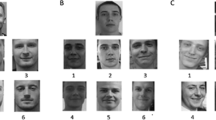Abstract
The goal of this study was to examine whether individual differences in the intensity of facial expressions of emotion are associated with individual differences in the voluntary control of facial muscles. Fifty college students completed a facial mimicry task, and were judged on the accuracy and intensity of their facial movements. Self-reported emotional experience was measured after subjects viewed positive and negative affect-eliciting filmclips, and intensity of facial expressiveness was measured from videotapes recorded while the subjects viewed the filmclips. There were significant sex differences in both facial mimicry task performance and responses to the filmclips. Accuracy and intensity scores on the mimicry task, which were not significantly correlated with one another, were both positively correlated with the intensity of facial expressiveness in response to the filmclips, but were not associated with reported experiences.
Similar content being viewed by others
References
Adelmann, P.K., & Zajonc, R.B. (1989). Facial efference and the experience of emotion.Annual Review of Psychology, 40, 249–280.
Berenbaum, H. (1987).Blunted affect and anhedonia in schizophrenia and depression. Unpublished doctoral dissertation, Indiana University, Bloomington, Indiana.
Berenbaum, H., & Oltmanns, T.F. (1992). Emotional experience and expression in schizophrenia and depression.Journal of Abnormal Psychology, 101, 37–44.
Berenbaum, H., Snowhite, R., & Oltmanns, T.F. (1987). Anhedonia and emotional responses to affect evoking stimuli.Psychological Medicine, 17, 677–684.
Berenbaum, H., & Williams, M. (1992).Arousal, emotional reactivity, and extraversion. Manuscript submitted for publication.
Buck, R. (1977). Nonverbal communication of affect in preschool children: Relationships with personality and skin conductance.Journal of Personality and Social Psychology, 35, 225–236.
Buck, R., Miller, R.E., & Caul, W.F. (1974). Sex, personality, and physiological variables in the communication of affect via facial expression.Journal of Personality and Social Psychology, 30, 587–596.
Cacioppo, J.T., Uchino, B.N., Crites, S.L., Snydersmith, M.A., Smith, G., Berntson, G.G., & Lang, P.J. (1992). Relationship between facial expressiveness and sympathetic activation in emotion: A critical review, with emphasis on modeling underlying mechanisms and individual differences.Journal of Personality and Social Psychology, 62, 110–128.
Cupchik, G.C., & Poulos, C.X. (1984). Judgements of emotional intensity in self and others: The effects of stimulus context, sex, and expressivity.Journal of Personality and Social Psychology, 46, 431–439.
Ekman, P., & Friesen, W.V. (1975).Unmasking the face. Englewood Cliffs, NJ: Prentice-Hall.
Ekman, P., & Friesen, W.V. (1978).Facial action coding system. Palo Alto CA: Consulting Psychologists Press.
Ekman, P., Hager, J.C., & Friesen, W.V. (1981). The symmetry of emotional and deliberate facial actions.Psychophysiology, 18, 101–106.
Ekman, P., Roper, G., & Hager, J.C. (1980). Deliberate facial movement.Child Development, 51, 886–891.
Field, T.M., & Walden, T.A. (1982). Production and discrimination of facial expressions by preschool children.Child Development, 53, 1299–1311.
Hall, J.A. (1984).Nonverbal sex differences: Communication accuracy and expressive style. Baltimore: Johns Hopkins University Press.
Izard, C.E. (1971).The face of emotion. New York: Appleton-Century-Crofts.
Kring, A., Kerr, S., Neale, J.M., & Smith, D.A. (1990).Empirical confirmation of paramimia in schizophrenia. Paper presented at the fifth annual meeting of the Society for Research in Psychopathology, Boulder, Colorado.
Lang, P.J. (1979). A bio-informational theory of emotional imagery.Psychophysiology, 16, 495–512.
Levenson, R.W., Ekman, P., & Friesen, W.V. (1990). Voluntary facial action generates emotion-specific autonomic nervous system activity.Psychophysiology, 27, 363–384.
Manschreck, T.C. (1983). Psychopathology of motor behavior in schizophrenia.Progress in Experimental Personality Research, 12, 53–99.
Notarius, C., & Levenson, R. (1979). Expressive tendencies and physiological response to stress.Journal of Personality and Social Psychology, 37, 1204–1210.
Rinn, W.E. (1984). The neuropsychology of facial expression: A review of the neurological and psychological mechanisms for producing facial expressions.Psychological Bulletin, 95, 52–77.
Ross, E.D., & Mesulam, M.M. (1979). Dominant language functions of the right hemisphere? Prosody and emotional gesturing.Archives of Neurology, 36, 144–148.
Tomkins, S.S. (1962).Affect, imagery, consciousness. Vol. 1. The positive affects. New York: Springer Publishing Company.
Zuckerman, M., Hall, J.A., DeFrank, R.S., & Rosenthal, R. (1976). Encoding and decoding of spontaneous and posed facial expressions.Journal of Personality and Social Psychology, 34, 966–977.
Author information
Authors and Affiliations
Additional information
We wish to thank the Editor and two anonymous reviewers for their helpful comments on an earlier draft of this paper.
Rights and permissions
About this article
Cite this article
Berenbaum, H., Rotter, A. The relationship between spontaneous facial expressions of emotion and voluntary control of facial muscles. J Nonverbal Behav 16, 179–190 (1992). https://doi.org/10.1007/BF00988033
Issue Date:
DOI: https://doi.org/10.1007/BF00988033




